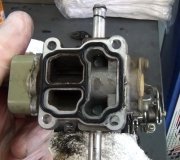Yes, when throttle is opened, the solenoid would click to allow vacumn to work the EGR valve. The diaphragm that you mentioned is the back pressure transducer. It prevents the EGR valve from closing abruptly when the solenoid stops working.
Here are testing ptocedures for the EGR.
1. Check vacuum lines for correct routing. Disconnect vacuum hose at EGR valve, and plug hose end. Connect vacuum pump to EGR valve. Start engine. Apply 4.7 in. Hg to valve and hold.
2. Engine speed should drop at least 100 RPM or engine should stall. Vacuum should not drop more than one in. Hg in 30 seconds. Reconnect EGR vacuum hose. With engine warm, increase engine speed. Ensure EGR valve stem moves up.
Thursday, July 16th, 2009 AT 1:42 PM



